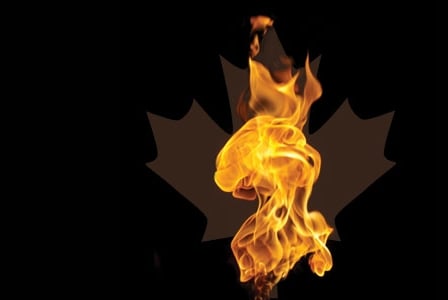
Hydraulic fracturing is a controversial gas extraction method used in North America. Also known as fracking, it poses serious environmental and health concerns.
Hydraulic fracturing is a controversial gas extraction method used in North America. Also known as fracking, it poses serious environmental and health concerns.
What is fracking?
Fracking involves pumping a cocktail of toxic chemicals mixed with water and sand as deep as 2.5 km (1.5 miles) into the earth. The high pressure effectively creates mini earthquakes that break up rock and release gas.
The type of gas that fracking retrieves is found packed tightly in shale rock deep underground. Before fracking, this gas was impossible to retrieve, but as natural gas sources become increasingly scarce, more dangerous methods of recovering gas, such as fracking, are being used.
|
A toxic soup Depending on the kind of fracking fluid used, hundreds of chemicals may be used as additives including:
Some of the chemicals in the flowback fluid include:
|
Water quantity concerns
A fundamental concern about fracking is its immense use of fresh water. The specific amount of water used depends on a variety of factors, including what kind of earth is being drilled.
For shale gas, the US Environmental Protection Agency (EPA) states that 2 to 5 million gallons (about 7.5 to 19 million litres) of water may be needed per well when drilling in a shale formation. One calculation estimated the amount of water needed for 10 wells in the Horn River Basin of BC at more than 909,000 cubic metres—that’s enough to fill over 360 Olympic-sized swimming pools!
When this amount of water is extracted from aquifers, groundwater, or surface water, the delicate balance of the natural environment is disrupted. In aquifers, chemical changes to minerals can occur, as well as bacterial growth.
Water quality concerns
In order to break up the rock more effectively, additives are added to the fracking fluid. Some of these ingredients are relatively benign, but others are dangerous (see above for examples).
Much like a perfume’s secret list of fragrances, the exact combinations and amounts of chemical additives in fracking fluid are considered trade secrets and are therefore not revealed to the public. Without this information, it’s impossible to analyze the exact impact the fluid has on the environment.
If these chemicals leach into the environment, they can contaminate clean drinking water. Substances naturally found underground, such as radioactive elements, heavy metals, and gases, can also pose a threat to health. It’s possible that these substances are disrupted by the fracking process and can then make their way into drinking water sources.
Once fracking is completed, the fluid flows back to the surface. According to the National Energy Board, water that has been used for fracking shale gas is typically injected deep into the earth in order to dispose of it. It can also be recycled and used at another fracking well or be taken to a treatment facility. Water treatment requires extensive space and resources because of the amount of chemicals the waste water contains.
However, not all the fluid is disposed of; only 15 to 80 percent of the fluid from shale gas is recovered. Like the fracking fluid, this “flowback” also contains high concentrations of chemicals (see above).
A recent study by a group of Cornell researchers concluded that fracking is worse for the environment in terms of greenhouse gases than conventional sources of gas and oil. They estimated that methane emissions from shale gas production are at least 30 percent higher than conventional gas production methods.
Given the amount of water and chemicals used, it’s not surprising that fracking accidents such as spills and leaks can, and do, occur. These cause environmental damage to groundwater aquifers and drinking water, create air pollution, increase carbon dioxide emissions, generate wastewater disposal problems, and lead to the loss of farmland and wildlife habitat.
Anti-fracking crusaders
Despite these concerns, fracking received little publicity until American filmmaker Josh Fox made the documentary Gasland. After an energy company offered him money so they could drill on his family’s land, Fox became curious about fracking and set out to learn more about it. The result was Gasland (gaslandthemovie.com).
Because of Fox’s film, fracking is perhaps most well-known in the United States. However, fracking is also occurring in Northern BC, Alberta, and Eastern Canada. Drilling in Two Island Lake in Northern BC, dubbed the “largest frack in the world,” drew attention to fracking in Canada in 2010.
After fracking occurred near her home in Rosebud, Alberta, Jessica Ernst could light her water on fire. This can occur when the methane content of water is too high. Underground sources of methane may be released by the fracking process, although methane may also come from a natural source—decayed organic matter located near the earth’s surface. She has filed a lawsuit against the energy company Encana for water contamination.
“Most of my life I’ve tried to live healthy, not just healthy foods, but also by living rurally,” says Ernst, “and there I was, bathing in toxic chemicals.” The oil industry denies that fracking is the cause of high methane content in drinking water.
Ernst believes that although filing a lawsuit is both difficult and intimidating, it will be worthwhile even if she does not win because of the attention she has brought to the issue. As she says, “I understand what I’m up against and believe I’m already victorious.” One of her main goals, she explains, is mandatory disclosure of the exact chemicals used in the fracking process.
The future of fracking
It’s difficult to determine the future of fracking. In early 2010 the EPA announced it would launch a formal investigation into fracking’s impact on drinking water. Their draft plan was released just over a year later, and interim results should be ready in 2012.
The results of this study may impact fracking in Canada as well as the United States. However, the problem is far from resolved, as those in the oil and mining industries continue to defend the process, claiming that the pros outweigh the cons.
Nevertheless, Fox’s documentary has spurred an outpouring of anti-fracking activism in Canada. (The Canadian group Stop Fracking in Nova Scotia, for example, was inspired by Gasland).
Across the country, citizen groups (see below) are taking matters into their own hands and organizing against fracking in their communities. Anti-fracking activists recently held a 600 km (372 mile) month-long march to Montreal to protest shale gas. Furthermore, Quebec has ordered a moratorium on fracking, while some New Brunswick citizens and First Nations leaders are calling for an outright ban.
Individual efforts can make a huge difference. Ernst urges all Canadians to act before fracking occurs in their area. Once fracking begins, she explains, it becomes much more difficult to fight.
Signing petitions, contacting your local MP, and telling others about fracking are all simple but important forms of activism that anyone can engage in. Ernst suggests writing open letters to local politicians and sending copies to local newspapers so all residents can learn about the issue.
“Water is much more critical than gas or oil. We can do better,” proclaims Ernst. In the quest for more energy, there’s no need to put our health and the environment in jeopardy by prioritizing gas over drinking water.
Too close to home
According to the Energy Board of Canada, there are 1,000 trillion cubic feet of shale gas. Some of the most prominent sites where fracking is occurring, or being evaluated, include:
- Western Canada: Two Island Lake, Montney Basin, Horn River Basin, Western Canada Sedimentary Basin, Horseshoe Canyon Area
- Central Canada: Antrim Shale, Utica Shale, Marcellus Shale
- Eastern Canada: Horton Bluff Shale
Want to get involved?
If the thought of your tap water on fire is enough to get your blood boiling, check out these Canadian organizations involved in the anti-fracking movement.
Across Canada:
- Fracking Canada frackingcanada.blogspot.com
- Sierra Club Canada sierraclub.ca
- The Council of Canadians canadians.org/water/issues/fracking/index.html
Western Canada:
- Peace Environment and Safety Trustees bcpest.ca
- BC Tap Water Alliance bctwa.org
Central Canada:
- Stop Fracking Ontario stopfrackingontario.wordpress.com
- No Fracking Way! Quebec nofrackingwayquebec.org
Eastern Canada:
- Stop Fracking in Nova Scotia stopfrackinginnovascotia.ca
- Ban Fracking New Brunswick banfrackingnb.ca
- Ecology Action Centre ecologyaction.ca



